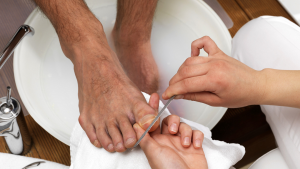How Do You Practice Good Foot Hygiene?
Not all individuals consider foot cleanliness as a major aspect of their day by day schedule, yet it ought to be. Since our feet are the establishment of our versatility, we have to tend to them and focus on any issues that emerge; generally, our capacity to walk, work, do errands and take part in recreational exercises might be traded off. Rehearsing great foot hygiene is a foundation for preventive foot wellness.

Foot cleanliness includes more than just washing your feet when you scrub down or shower. Try the following steps.
1. Day by day Foot Care
Always wash and dry up your feet consistently. Make use of gentle cleansers and wash between the toes. Make sure to dry completely, particularly between the toes. Do not use acetone to clean the SNS dipping powder on your toenails.
Always put on socks and change them daily—more often if you are dynamic and you sweat intensely. Blends and fibres that are man-made help move (“wick”) dampness far from the feet, lessening the odds of diseases, for example, blisters or athlete’s foot.
Always keep your shoes neat.
Swap shoes—don’t wear one shoe two days in succession. Give your shoes time to dry out, particularly in the event that you are dynamic or sweat intensely.
For ideal foot wellness, wear appropriately chosen and fitted shoes, as a major aspect of a coordinated approach, cushioned socks with shoes with non-slip outsoles and any additions or orthotics endorsed by a specialist or foot wellness professional. Always wear shoes, especially when out in the public; and endeavour to wash your feet afterwards.
2. Toenail Care
Trim toenails frequently. Cut them straight over, not on a bend, and file out sharp edges with an emery board.
Use neat scissors or clippers. Disinfect them intermittently by drenching them in alcohol.
Do not try to cut your toenails all by yourself because you will experience difficulty reaching them and can’t see them properly, or in the event that you have diabetes and additional neuropathy (loss of sensation in the feet), fringe vascular ailment or other circulatory issues in the legs and feet. Rather, visit a professional.
Visit a physician for stained toenails, which could suggest a basic medical problem. Sound toenails ought to be pale pink where they are joined to the skin, and the part that grows over the toe ought to be clear where it isn’t clung to the skin.
Do not put nail clean or polish on stained toenails. If you are a fashion designer or you like to decorate your toenails, please use safe and friendly pedicure products as DND nail polish.
3. Every day Foot Inspection
Check the bottom and top of your toes, as well as your feet, also check in between your toenails and your toes. Check for the following:
Wounds, blisters, lumps and bumps.
Cuts, injuries, or split skin. Indeed, even the smallest split can end up plainly tainted.
Temperature contrasts (one section warm, another chilly). These can flag absence of blood stream.
Pain, shivering, deadness and having no feelings are abnormal and can flag nerve problems.
Ingrown toenails with red, puffy skin along the nail and delicacy or torment.
Hair around the foot falling off is also a serious health issue.
If you experience difficulty seeing the base or different parts of your feet, a mirror can help you do that.
If your feet hurt, try to recognize the source and oversee it adequately.
If you can’t tell where the discomfort is, or if pain does not leave on its own, go see a physician. Bear in mind that minor issues can end up badly if left alone and neglected.